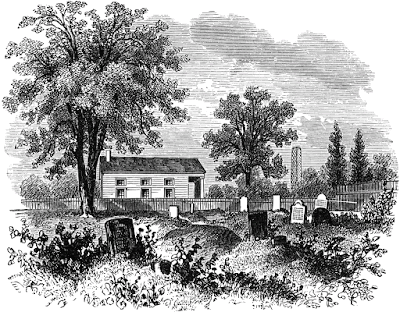Today is the anniversary of the Battle of Lundy's Lane in 1814. Here are some pictures and insights from my 2018 visit.
If Chippawa is a battlefield preserved, Lundy's Lane is a battlefield lost—or at least obscured. The urban sprawl of the modern day town of Niagara Falls has almost obliterated the battlefield. Still, there are hidden nuggets to be found to reward a visitor searching for a link to the past. After all, the history of one of the largest, deadliest and most confusing battles of the War of 1812, can still compel one to visit the site.
Lundy's Lane Battlefield was a tourist tradition from about 1820 until 1865, in part because both Americans and Canadians claimed victory, contributing to its popularity. Large observation towers were constructed and veterans from the battle served as guides. After the American Civil War the appeal of visiting Lundy's Lane was eclipsed by more recent and vast battles in places like Gettysburg and Antietam. The Lundy’s Lane observation towers were eventually torn down, which helped make room for attractions more familiar to us now.

Today, it's almost like the town has become one giant theme park! Because the battlefield is so built up, with a major roadway cutting across it, carrying buses and cars with people from all over the world to see the natural wonder of Niagara Falls. And all the tourist trappings such as wax museums, fast food places, parking lots, and souvenir shops, it takes some imagination to walk the land and picture how it was back in the summer of July 25, 1814. Thanks to the personal efforts of Miss Ruth Redmond, a schoolteacher, who bought up parcels to keep from development, at least some of the battlefield was saved.

I recommend you start with a visit at The Niagara History Museum, about two blocks down the road. The very friendly Canadians there gave me an excellent walking tour map which is a must-have to visit the area. In addition, the Museum has a succinct exhibit about the Battle of Lundy’s Lane and the War of 1812. There are uniforms, artifacts and stories about soldiers from each side. A short audio visual presentation features reenactors in period uniforms. Best of all there’s a hands-on opportunity to try on reproduction uniform coats and shakos from the 8th Regiment of Foot, and heft a reproduction musket. It was great fun watching children (as well as a few adults!) enjoying these items.
From the Museum you can walk up the road to Lundy’s Lane Battlefield as parking can be difficult. Or, you can follow our lead and stop at the nearby Starbucks. I got a head start, marching off, books and maps in hand to explore, while Janine parked and got us an iced coffee.
After successfully navigating the onslaught of traffic, across the busy street I found the site of the Red Meeting House (which is still a church) and the cemetery (which has greatly expanded). These landmarks allow one to mark out positions of the British line and American attacks with some accuracy.
My march across the paths to the southeast corner of the cemetery led me to find the area where American Colonel James Miller and his 21st US Infantry regiment surprised and captured the British artillery line. His iconic answer when asked if he could capture the guns, "I'll try sir!" is the motto of the present day 5th Infantry Division. Examining the folds of the ground and imagining the fading light, I could better understand how he managed this.

In the cemetery there are a number of markers and monuments. As a resident of Massachusetts, I looked for and found the marker to Captain Abraham Hull of the 9th US Infantry regiment who was killed during the battle and buried on the field. He was the son of General William Hull who surrendered Detroit and nephew of Commodore Isaac Hull of the USS Constitution. With him are buried nineteen other American soldiers who were discovered in 1900 and reburied here. There is always something moving and mysterious about the graves of unknown soldiers


On the Starbucks side is a park with waysides, markers and displays (along with the small Battle Ground Hotel Museum which was closed). Walking down the slope I found where General Drummond rallied the British and Canadian forces to try and retake the captured cannon atop the hill. It was near here, between the Americans on the top of the hill and the British on the lower slope where General Winfield Scott stumbled in the dark with the remnants of his brigade. This was after dark and the fighting had been raging at point blank range. Marching his brigade between the two antagonists in the pitch darkness his men were decimated by musket fire of friend and foe and he himself badly wounded. Fighting in this area continued until just after midnight. Exhausted, both sides withdrew ending the fighting.
I enjoyed my visit very much and came away with a better impression of what happened during the battle. I’d like to emphasize the value of a good map, as it will reward a visitor with a better understanding of this complicated and confusing battle, as well as sort through the modern day landscape for clues to what it once looked like. I walked the field with A Crucible of Fire, by Robert Feltoe, which greatly assisted me. The best study of this highly confusing battle is Donald E. Graves's "The Battle of Lundy's Lane: On the Niagara in 1814."
.jpeg)






















.jpeg)
